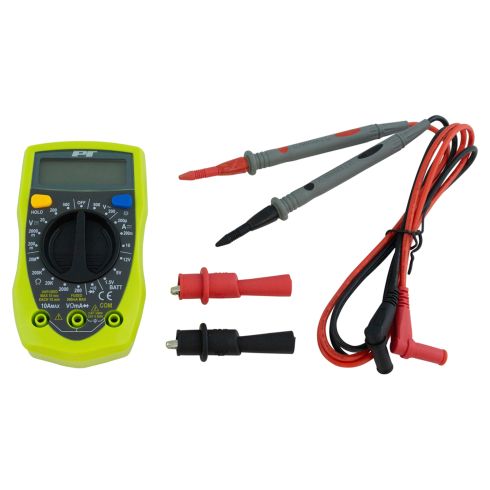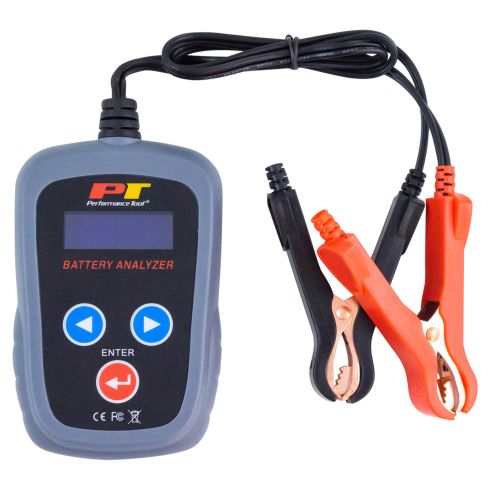
It can be tiring to have to constantly jumpstart and recharge your car’s battery. If the battery’s voltage reads fine at 12.4 to 12.5 volts and is charged but has trouble starting the next day, you can test the car’s battery health. This can usually be completed with a battery analyzer, refractometer, and a multimeter. If the battery’s condition passes as useable, then you can test the charging system and for a parasitic draw. This article mostly explains how to test the car’s internal battery health with a refractometer.

How to Check the Car Battery
You can test your car battery with a few different tools listed below. This post is mostly about how to check the car battery internally with a refractometer.
1. Test the Car Battery with a Multimeter
You can test your car battery’s health with a multimeter, but that won’t be useful when testing the internals of the battery, like the strength of the battery acid. Multimeters are useful for testing voltage.
This article explains how to test the battery for charge with a multimeter
2. Test the Car Battery with a Battery Analyzer
You can also test the battery with a battery analyzer. The battery analyzer will connect to the positive and negative terminals and can read the battery’s condition, its charge, and data about the alternator and starting.
3. Test the Car Battery with an Advanced Battery Charger
If you have been charging the battery every day and it works intermittently, an advanced battery charger can read the condition of the battery before it starts charging.
Test the Car Battery with a Refractometer
A refractometer will have a chart that can measure the battery charge level. Do not get the chemicals on your hands or in your eyes or mouth. Do not place any flammable objects or make a spark near the chemicals.
Safety Tip: If you decide not to use safety protection and happen to get battery acid on your skin or in your eyes, neutralize the battery acid as soon as possible by cleaning it with water. Ideally an emergency eyewash station will be available for use, but if not, run water from the sink and try to neutralize as much acid as possible. Then seek medical attention right away.
How to Use a Refractometer to Check the Car Battery
- Remove the Negative Battery Terminal
Remove the negative battery terminal. Check the terminals for corrosion and remove any at the end of this process. Corrosion can affect the condition of the battery over time.

- Lift the Vent Covers on the Battery
Wearing eye and hand protection, grab a pry bar or a screwdriver and lift up on the vent covers on the battery.

- Check the Battery’s Cells for Debris
Look inside the cells with a flashlight for chunks of debris, which could be from the plates, indicating they are defective.

- Place a Sample of Battery Acid on the Refractometer
If the cells look okay, flip open the refractometer and take a sample of the battery acid for testing. Place a drop on the refractometer. Do not get the acid on your skin or in your body like your eyes or mouth.

- Check the Battery Acid’s Condition with the Refractometer’s Chart
Close the tab on the refractometer and check the chart in the refractometer. If the measurement is in the “good” range, the battery is in good condition. If it is in the “fair” range, the battery is in okay/fair condition.
You can try recharging a battery in the “recharge” range, but the cells are likely no good, especially if only one cell measures in the “recharge” range. All the cells have to be tested and read in good condition for the battery to be in good condition.
Have a clean surface on the refractometer before testing each cell. One bad cell can affect how the battery performs and can cause start up issues.
Test each cell. As long as each cell has a consistent rating of good or okay, the battery is useable.
- Replace the Battery’s Vent Covers
Replace the vent covers firmly. Tap them in with the end of a screwdriver’s handle to secure them. If the vent covers aren’t pressed in as far as possible, moisture can collect inside the battery cells, contaminate the fluid, and reduce the battery’s charge.

- Clean Corrosion off the Battery Terminals
Many people use hot water and baking soda to clean corrosion off the battery terminal, but that can also seep inside the vent covers and contaminate the cells. Hot water and a battery terminal cleaner tool or a brush is the best way to remove corrosion from a battery terminal.
Once you’re confident you have a working battery that’s completely charged, you can try a charging system test and then a parasitic draw test. Check out the videos below for more information on how to do these diagnostic tests.
How to Perform Battery Current and Draw Test
The video below shows how to perform a battery current and draw test.
How to Perform a Parasitic Draw Test
The video below shows how to perform a parasitic draw test. Check out 1A Auto’s how-to videos for more diagnostic tips and repairs for many years, makes, and models.
Related Content
- How to Test a Fuse with a Multimeter
- The Battery or Alternator?
- How to Diagnose Car Problems Without Special Tools
Shop Parts and Tools at 1A Auto






